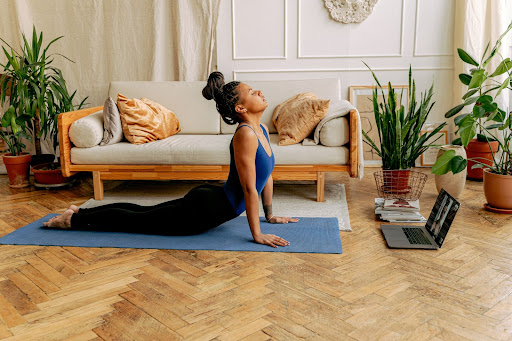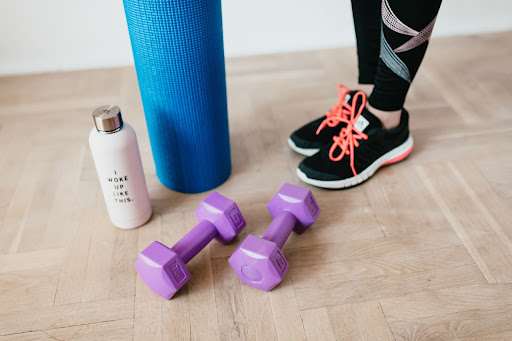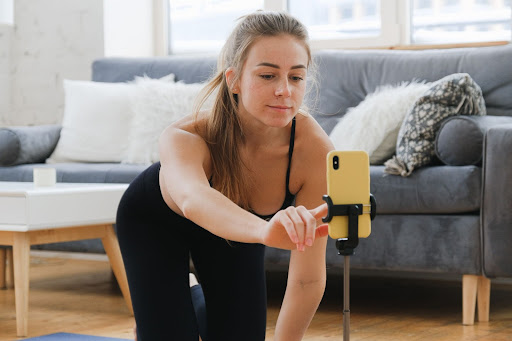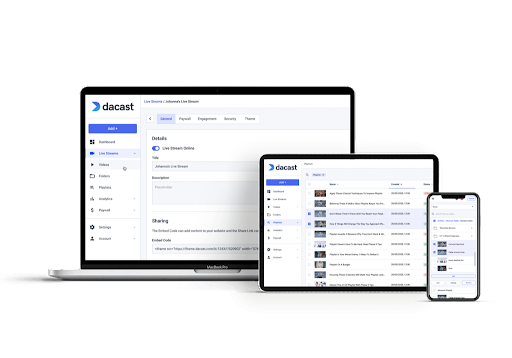How to Start Your Online Fitness Business in 2022
It’ll never be a better time than today for you to start an online fitness business. Former baseball player Sahil Bloom says it best: “Every single time I thought I was too late, it was still early.”
Although COVID sucked in many ways, not many people can deny that it forced them to embrace the digital world. Because of that, online fitness businesses are booming.
Reputable in-person trainers to newbies alike are becoming curious on how to start an online fitness business in 2022. So, whether you want to learn how to grow an online personal training business or just want to learn how to become a fitness influencer, we’ll break it all down for you.
In this post, let’s talk about what you’ll need to get started without breaking the bank. Let’s explore everything, including how to market yourself, streaming software tips, and the different ways to make money.
Let’s jump into it.
Table of Contents
- Why Start an Online Fitness Business in 2022
- How to Start Your Online Fitness Business in 13 Steps:
- How To Start
- Differentiate Yourself From Influencers With Large Followings
- Decide On Your Fitness Niche
- Determine Your Ideal Audience
- Set Up Your Training Space With the Right Equipment
- Build Your Brand and Visual Identity
- Set Up the Website
- Decide On Pricing
- Video and Audio Equipment
- Pick the Best Streaming Platform
- Create Content
- Market Your Fitness Service
- Create a Community
- Final Thoughts
Why Start an Online Fitness Business in 2022

The lure of online fitness as a profitable business took a bit to kick off. Even you might’ve wondered why people would pay for online fitness professionals when there are plenty of free videos online. It’s not until people try to commit to free videos that they realize there’s zero accountability, among many other factors that are necessary for a successful fitness journey.
Many people eventually get sick of repeated failures after trying to do it on their own using free videos.
A few of the many benefits your future clients will love about paying for fitness services online include:
- Form critique
- Exercise modification tips due to joint problems
- Weekly check-ins
The reality is that, for the most part, the way people train and eat should be custom-tailored, and fitness is definitely not a one-size-fits-all. Here’s where your value comes in.
How to Start Your Online Fitness Business in 13 Steps:

Starting an online fitness business can be exciting but scary. As long as you stay consistent in following the steps we’ll talk about, you’ll be ahead of the game compared to people who choose to play things by ear or give up after a few weeks of no traction.
Commitment is the name of the game. It happens, but it’s very rare that your online fitness business will explode after 1 week or even 1 month. Before you get started, make sure to set realistic expectations and timelines with yourself and know that there will be challenges. Determine how you’ll cope in advance.
With that said, here are the steps on how to build an online fitness business.
1. How To Start
The best way to start is to just throw yourself in. Tell friends and family about your plans, so you have people to keep you accountable. Nothing will be perfect at the start, but it’s easier to make improvements along the way once you put your online business out in the real world.
Don’t get discouraged by feeling like you need to create long business plans. This often seems scary to people who are new to starting businesses. Sure there could be some benefit in business plans that are 20 pages long, but right now, it’s more of a distraction. Keep it super simple in the beginning. To start, we recommend:
- Hubspot’s one-page business plan template.
- The 1‑Page Marketing Plan by Allan Dib (it’s a book, but you can google the template for free too).
2. Differentiate Yourself From Influencers With Large Followings
When you first start exploring how to run an online fitness business, you might be a bit intimidated that there are already thousands of huge fitness influencers, but don’t be. Here’s why. With hundreds of thousands of followers, fitness influencers can sometimes feel too out of touch for many people.
Many people love being a part of smaller groups because the leader is more accessible. Imagine joining a yoga platform led by someone with a million followers. It’s easy to feel like just another number, and good luck trying to get a 1-on-1 with that influencer.
In other words, there’s less accountability in bigger groups, and you should definitely use that to your advantage when marketing your smaller service.
3. Decide On Your Fitness Niche

If you haven’t already, expose yourself to different types of fitness influencers on social media to get inspired. Which niches fascinate you? There are so many options to choose from. Here are some examples:
- Yoga for more energy
- Pilates for better posture
- Sports training
- Personal training for stronger legs
- Mobility training to reduce injury
- Police training to pass physical exams
- Rehabilitation to recover from specific injuries
- Healthy eating for those with a gluten-intolerance
- Speed training for athletes
4. Determine Your Ideal Audience

When learning how to start an online personal training business, please avoid the common newbie mistake of trying to appeal to everyone. Facebook first started as a social media for Harvard students, and they eventually built on that momentum to earn the right to appeal to everyone. Like Facebook, most successful businesses start out very targeted to gain traction.
Getting clear on your ideal audience also makes it easy to market. For example, if you provide workouts for high school quarterbacks, you can make more targeted pieces of content such as “arm workouts to improve throwing accuracy”, or “arm workouts to improve throwing power”. Imagine a high school quarterback seeing that vs. “arm workouts for stronger arms”. That’s so generic.
Likewise, it’ll help you choose photos for your website. For example, women in menopause probably won’t be inspired by pictures of male athletes with ripped abs.
Some target audience ideas to get your creativity flowing include:
- People who live in apartment buildings
- Women in their 30s post-pregnancy
- Moms who have recently had a C-section
- Women basketball players
- Really busy professionals in corporate jobs
- Women in their 30s with desk jobs who are worried about posture
- Members of the LGBTQ+ community
Many people feel hesitant to get so specific, but author Kevin Kelley’s concept of 1,000 true fans explains it best. Many people start by thinking about reaching millions of people, but you truly don’t need that much of a following to make a good living. If you can get only 1,000 people to invest $100 in you per year through a mixture of offers and services, that’s already $100k a year.
5. Set Up Your Training Space With the Right Equipment

You don’t need a huge gym space. As long as you can set the camera far away enough to capture the full length of you standing and laying down, it’ll generally be good enough.
If you don’t have natural lighting, consider investing in a ring light to point towards you. And when setting up the camera, try to make sure it doesn’t point towards a light source.
As far as equipment, how much you decide to invest is completely up to you. There are plenty of bodyweight exercises, athletic drills, and more that don’t require any equipment whatsoever.
Some basic pieces of equipment to consider are:
- Dumbbell set
- Resistance bands
- Large exercise ball
- Yoga mat
- BOSU ball
- Portable bench
- Kettlebells
- Medicine ball
- Slam ball
Make sure to choose bright colored equipment because it’s easier for your clients to track on video.
6. Build Your Brand and Visual Identity
Once you’ve chosen your ideal audience, build your brand and visual identity in a way that’d appeal to them. Here’s a good time to look at the various influencers again to draw inspiration.
This step includes creating a logo, choosing your brand colors, and the type of photographs you want to exemplify your brand. One tip to keep in mind is to be consistent with your brand on all platforms. For example, have a consistent photo and name on all social media platforms.
You might think that it’s obvious that it’s you and people should know better, but remember, it’s the small things that add up and build momentum.
7. Set Up the Website
In our opinion, having a website should be a non-negotiable. It helps you look more professional and it’s also a great place to funnel people into from all your social media channels.
Sure, there’s no denying that social media in 2022 is powerful. However, you just have to be aware that ultimately, you don’t have full control over social platforms. If one day Instagram decides to shut down your account for violating a rule by mistake, it can take weeks before you’re back up. For that reason, we strongly recommend you have a website where you can continue business no matter what.
If you’re new to marketing, keep it simple. Look at a few websites of competitors and model them. It’s a common newbie mistake to try to get too creative. Just stick to what’s been proven to work. As you grow and learn marketing, then you can get more creative. For example, keep the menu names simple such as: home, about, schedule, blog, contact.
Tip: A website is also a great place to collect emails. In exchange for emails, offer something like a free workout template PDF or a cool recipe.
8. Decide On Pricing
Now let’s move on to the next step on how to create an online fitness business: money. Let’s go into detail about common class types, their pricing, and other pricing models:
- Prerecorded classes: A great way to scale your time, but generally cheaper, like $10 a month. You’ll really need to work on generating big followings because you’ll need a higher number of people paying for this service to gain enough traction to make a living from it.
- One-on-one: With this model, you’re limited to about 5-25 clients but can generally charge more because you can provide live feedback. Of course, it depends on training frequency, but you can charge people anywhere from about $100-$1000/month as an estimate.
- Group live stream classes: People love joining group live streams because of the sense of community compared to one-on-ones. You’re also still able to give feedback to individuals, just not as much. Of course, you’ll generally charge less per person for group classes, but a bit more than what you charge for prerecorded classes.
- Hybrid programs: Consider offering a mix of everything.
- One-off pricing: This is when you charge per live class, like $10 for one class.
- Package pricing: This is when you give small discounts for buying in bulk. For example, 20 classes for $170 or 5 classes for $45.
Additionally, there are sponsorships, subscriptions, and affiliate sales.
The pricing recommendations are estimates based on what common platforms charge and what others have reported charging. On top of those estimates, if you’re starting an online personal training business specifically, consider that according to ziprecruiter, online personal trainers make $24 /hour on average.
9. Video and Audio Equipment

When you’re first learning how to start your own personal training business online, don’t stress about needing to get too fancy. You can invest in professional cameras and microphones as you scale, but webcam or mobile live streaming will be fine in the beginning. Here are just three inexpensive pieces of streaming equipment to consider for now:
- Tripod
- Phone mount
- Wireless lavalier mic
10. Pick the Best Streaming Platform

Your website and the streaming platform you choose are equivalent to the physical gym you’d lease if you were doing in-person training. You want something aesthetically pleasing with a good vibe, ultimately providing an amazing experience. And unlike some industries, fitness is very visual.
The streaming platform you choose will play a big role in the overall experience you deliver. When selecting a streaming platform, consider factors such as:
- Features to improve streaming quality
- Organized video content library
- Pricing models supported
- Features to prevent others from stealing and reproducing your videos.
Some streaming platforms to consider are Brightcove, Livestream, and Dacast.
With Dacast, for example, you’ll be able to:
- Access a powerful video paywall with multi-currency support
- Prevent others from stealing your videos with features such as watermarking and DRM
- Build apps using Dacast’s iOS and Android SDKs
- Make it easy for other to find videos with an organized video content library
- Broadcast classes to desktops and smart devices, including phones and TVs
- Create live channels for Apple TV, Roku, and Fire TV Stick
- Embed a white-label video player with your branding onto your own website
- Monetize your fitness content with pay-per-view, subscriptions, or advertising
- Use advanced video analytics to identify trends such as where most of your viewers are located and what devices they use
- Access customer support 24/7
Reputation is everything in the early stages. Invest in an all-in-one platform that allows you to provide the best experience. Doing so provides a domino effect— positive reviews, referrals, and your first set of raving fans.
Try Dacast for free for 14-days. After that, pricing starts at just $39/month.
11. Create Content
You’ll find that a large part of learning how to start an online fitness training business is understanding the importance of creating content. Constantly creating content is a way to show clients that you’re always “in the know”.
Some types of content you’ll create are:
- 10-20 second clips
- Longer videos
- Social media posts
- Ebooks
- Blog posts
- Emails
The content can be about anything. Here are some ideas to get you started:
- Exercise tutorials
- Exercise modifications for people with certain problems like knee pain
- New stretching techniques
- New cool fitness apps
- Healthy recipes
- Healthy versions of common junk food
- Healthy eating hacks
- Common mistakes with popular exercises
Also, a good way to come up with topics is to get them straight from your audience or clients. Notice a question that you’re constantly asked? Notice common answers within your questionnaires? Write it down and make content on it.
One major tip: Repurpose content to maximize your time. In practice, this basically would be creating a video about a new stretching technique. Turning that video into multiple 10-20 second Instagram or Tik Tok clips. And turning the video topic into a blog post. The same concept applies when you turn a live stream into a prerecorded video. You could basically build a program around prerecorded videos that were initially live stream sessions.
12. Market Your Fitness Service
Creating content and having your brand is one thing. Getting the word out there is another. Having some content already published will make selling your services so much easier. The idea is to show people you can help them by helping them in advance before they become paying clients.
Having a clear niche and ideal audience also makes marketing your service easier through word of mouth.
Imagine you help moms who struggle to lift after having a C-section. When someone who knows of you talks to a friend who recently had a C-section and is looking for an online fitness program, it’ll be much easier to remember you. Now suppose you’re a generalist. It’s doubtful that you’d pop up in someone’s mind when they’re randomly talking to a friend looking for a fitness program.
With that said, a sample end-to-end marketing process can look like this:
- College basketball player searches for something particular like “wrist exercises for basketball.”
- Your article pops up.
- Player binges on your content. Becomes a fan.
- Tells his friends.
- You create a $9/month subscription.
- Maybe only 1 out of 20 (5%) people who consume your free content invests.
- You do more marketing to get your free content in front of more eyes.
- Scale
Tip: Consider referral bonuses. For example, if someone refers a friend, offer the referrer a free month.
13. Create a Community

People love to make friends with like-minded people. Create a group or platform where like-minded people can exchange their own journeys and encourage each other. Using the pregnant woman’s example, they can motivate each other with breakthroughs and tips. A group can also be a great source of content ideas.
Run 1-day, 30-day, and 90-day challenges in the group and create accountability groups. Fitness lovers love these. Groups are also an excellent place to host weekly live Q&As and check in with your members between live sessions.
Final Thoughts
Other things to consider are a contractual agreement (with cancellation policy, refunds, etc.), liability release, and safety waiver forms. As you get started, you can google templates online, but you’ll eventually want to hire someone down the road to make it more all-encompassing.
With that said, we hope you feel a lot more excited and knowledgeable about how to start a fitness business online this year.
Take the first step of your journey by trying a Dacast free 14-day trial to see what all is possible.
 Stream
Stream Connect
Connect Manage
Manage Measure
Measure Events
Events Business
Business Organizations
Organizations Entertainment and Media
Entertainment and Media API
API Tools
Tools Learning Center
Learning Center Support
Support Support Articles
Support Articles